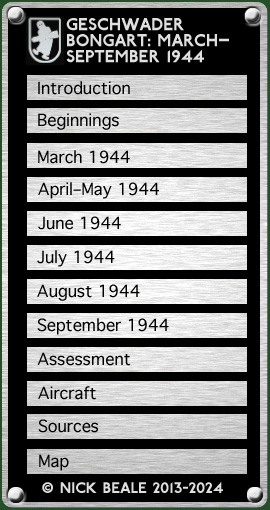|
Planned engagement of the terrorists established in the area east of Valence, constriction by combined Army-Luftwaffe operation on 21.7. Luftflotte 3 (midnight, 21 July1944) Two days earlier LXXX. Armee Korps, had signalled Châteauroux to solicit support for an operation due to commence at 04.00 hrs. on the 21st, around 30 km NE of Poitiers (settlements mentioned included Tournon-Saint-Martin, Vicq-sur-Gartempe and La Roche-Posay). The Army asked for reconnaissance of Saint Pierre de Maillé and bombing and strafing of various localities “to prevent [the] enemy from reinforcing.” It was only on the day of this planned offensive that Bongart responded, saying support was “impossible at the moment owing to commitments elsewhere.” Surprising the defenders is easier with gliders since they float down silently, close to the target … If the gliders come in out of the sun at first light, they are usually only first spotted as they come in to land. A glider operation is harder … to defend against than a paratroop one because a formed-up battle group can go over to the attack immediately after landing. A combat glider can land on any more or less open ground … What Every Airborne Soldier Must Know (II. Fallschirm Korps, 1 April 1944) That day German airborne troops of Kommando Schäfer landed on the Verecors Plateau in conjunction with a major ground assault: In support of an operation by the 157. Res. Div. against gangs in the area south of Grenoble, 44 aircraft of Geschw. Bongart were in action to secure the landing of 22 troop-carrying gliders during the morning. The[se] tasks were accomplished with the dropping of 7.5 tonnes of high-explosive bombs (by 36 aircraft). The air-landing of 22 cargo gliders went according to plan [and] the villages of Vassieux, La Mure and Le Château were occupied. Fourteen aircraft of Jafü Süd were committed to combating partisans by strafing, in the area south east of Valence. Invasions-Kalendar über den Einsatz der fdl. u. eig. Luftwaffe am 21.7.44 OB West’s daily report also stated that the Luftwaffe had bombed the “strongly fortified” villages of Saint-Julien- and Saint-Martin-en-Vercors while according to French sources, Pont-en-Royans was attacked too. The Maquis of the Vercors were taken by surprise: We’re about to leave a pine wood when aircraft appear, towing gliders … Our first impression is that it’s the Yanks. Our mistake doesn’t last long, about 10 seconds. Almost immediately … we make out the black crosses under the wings of a Dornier 17 which has just slipped its glider and is banking round to go and shoot up and bomb everything that moves at Vassieux. Some of the eight Bongart aircraft which did not bomb may have been assigned to reconnaissance duties. Troops of Kampfgruppe Zabel (9. Pz. Div.) moved to seal off the plateau from the south, battling their way along Route Nationale 93 in the Drôme valley against a succession of Resistance delaying actions. Two “mouchards” spotters were involved in a clash at 06.00 hrs. (local time) just east Aouste-sur-Sye. They circled the area, apparently without discovering the concealed Résistants, and loosed off a few machine gun bursts at nothing in particular. Shortly before midday, German aircraft flew over Saillans, firing at any perceived movement, and a spotter aided German deployments in the engagement around the road tunnel at the town’s eastern exit. In conjunction with armoured cars on the left bank, two more machines shot up Maquis positions at the tunnel, killing 11 men and wounding several more. Further along the road to Die, aircraft supported the advancing Germans against Maquis at the Espenel bridge in a fight lasting from 14.30 hrs. (local time) until nightfall, inflicting casualties with machine gun fire (the Resistance lost 14 dead and six wounded in all). A 39-strong group of Maquis was on the Col Saint-Alexis, wet through from the pouring rain which had set in: Toward 14.00 [local time], during a bright spell a German bomber comes to empty its bomb bay on the Bernards’ farm, where we’ve been quartered. Is it because there’s a car nearby? … this plane destroys the farm along with our radio receiver installed in the shed. Since Jagdgruppe 200 was active “south east of Valence”, it seems probable that its 14 Bf 109 sortiess were supporting Kampfgruppe Zabel while Bongart operated over the plateau (where the day’s targets were east of Valence, rather than south east). In the south west there was an aerial attack on a Resistance encampment NW of Carcassonne which may have been connected with an operation in that general area by Kampfgruppe Hax.
continued on next page …
|
|||

